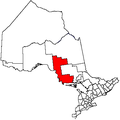Algoma District District d'Algoma | |
|---|---|
 Location of Algoma District in Ontario | |
| Coordinates: 48°00′N84°30′W / 48.000°N 84.500°W | |
| Country | |
| Province | |
| Region | Northeastern Ontario |
| Created | 1858 |
| Area | |
| • Land | 48,814.88 km2 (18,847.53 sq mi) |
| Population (2021) [2] | |
• Total | 113,777 |
| • Density | 2.4/km2 (6.2/sq mi) |
| Time zone | UTC-5 (EST) |
| • Summer (DST) | UTC-4 (EDT) |
| Area code | 705 |
| Seat | Sault Ste. Marie |
Algoma District is a district and census division in Northeastern Ontario in the Canadian province of Ontario.
Contents
- History
- Administrative history
- Geography
- Rivers
- Forests
- Subdivisions
- Cities
- Towns
- Townships
- Village
- Reserves
- Unorganized areas
- Demographics
- Highways
- King's Highways
- Secondary highways
- Tertiary highways
- Protected areas
- Attractions
- See also
- References
- Further reading
- External links
The name was created by an American ethnologist, Henry Rowe Schoolcraft (1793–1864), who was appointed Indian agent to the Ojibwe in Sault Ste. Marie region in 1822. "Al" is derived from Algonquin, while "goma" is a variant of gomee, meaning lake or water. [3]
Algoma District has shoreline along Lake Superior and Lake Huron. It has an international border crossing to the American state of Michigan, at Sault Ste. Marie. Historically, it was known for its lumber and mining industries.
The rugged scenery of the region has inspired works by Canadian artists, particularly the Group of Seven. They rented a boxcar from the Algoma Central Railway to travel on excursions through this region.

